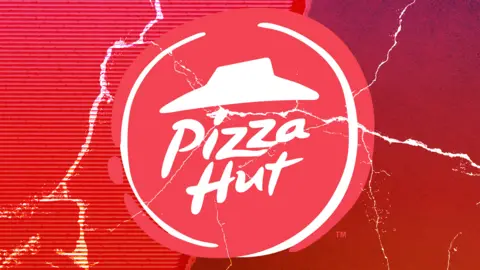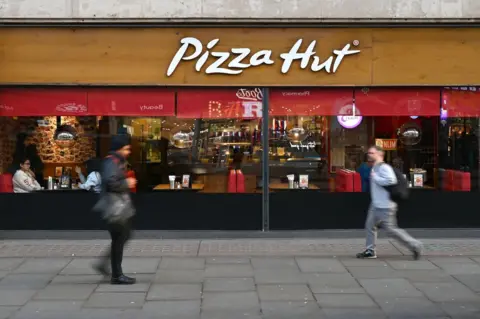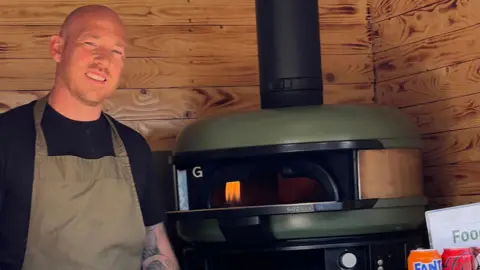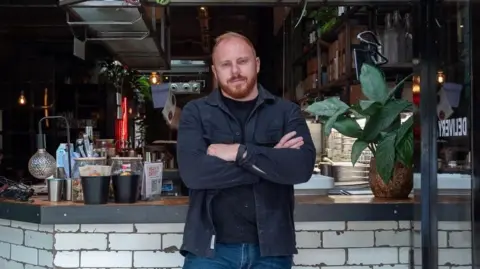What went wrong with Pizza Hut?

Faarea MasudBusiness reporter
 BBC
BBCPizza Hut was once a go-to for families and friends to tuck into its all-you-can eat buffet, unlimited salad bar, and self-serve ice-cream with all the toppings.
But fewer diners are “hitting the Hut” these days and it is closing half its UK restaurants after being bought out of administration for the second time this year.
“We used to go to Pizza Hut when I was a child,” says Prudence, when the BBC asked shoppers in London why they thought the chain was struggling. “It was like a family thing, you’d go on a Sunday – make a day of it.” But now aged 24 she says “it’s not a thing anymore”.
For 23-year-old Martina Debnatch it is some of the very things Pizza Hut has been known and loved for since it opened in the UK in the 1970s that are now not-so-hot.
“The way they do their buffet and their salad bar, it feels like they are cheapening on their quality and have lower standards…They’re giving away so much food and you’re like ‘How?'”

As food prices have soared, Pizza Hut’s all-you-can-eat model has become very expensive to run. As have its 132 restaurants which are being sliced to 64.
The business, like many others, has also seen its costs increase. In April this year, staffing costs jumped due to rises in minimum wages (which went up nearly 7% this year, to £12.21 for employees aged 21 and over) as well as an increase in employer national insurance contributions.
Chris, 36, and Joanne, 29 say they used to go to Pizza Hut for a date “every now and then”, but now they order in a Domino’s and think Pizza Hut is “very overpriced”.

Depending on your order, Pizza Hut and Domino’s prices are similar, says Giulia Crouch, food expert and author of The Happiest Diet in the World.
While Pizza Hut does offer takeaway and deliveries through Ubers Eats, Deliveroo and Just Eat, it is losing out to big rivals which solely cater to this market.
“Domino’s has managed to dominate the takeaway pizza sector thanks to aggressive marketing and constantly running deals that make consumers feel like they’re getting a bargain, when in reality the original prices are quite high,” says Ms Crouch.
But for Chris and Joanne it is worth it to get their date night delivered to their door.
“We definitely eat at home now more than we eat out,” says Joanne, echoing recent statistics that show a drop in people going to casual and fast-food restaurants.
 John Keeble/Getty Images
John Keeble/Getty ImagesOver the summer, casual and fast-food restaurants saw a 6% drop in customers compared to last summer.
There is also another rival to restaurant and takeaway pizzas: the cook-at-home oven pizza.
Will Hawkley, head of leisure and hospitality at KPMG, points out that not only have supermarkets been offering high-quality oven-ready pizzas for years – some are even selling home-pizza ovens.
“Lifestyle changes are also playing a factor in the success of fast-food chains,” says Mr Hawkley.
The rising popularity of high protein diets has boosted sales at chicken shops, while hitting sales of carb-heavy pizza, he adds.
As people go out to eat less frequently they may look for a more a premium experience and Pizza Hut’s American-diner style with booth seating and red and white checked plastic table cloths can feel more retro than upmarket.
The “explosion of high-quality pizzerias” over the last 10 to 15 years, such as Franco Manca, has “fundamentally changed the public’s perception of what good pizza is,” says Ms Crouch.
“A light, fresh, easy-to-digest product with a few choice toppings, not the massively greasy, heavy and overloaded pizzas of the past. That, I think, is what’s caused Pizza Hut’s downfall,” she says.
“Why would anyone spend £17.99 on a small, substandard, disappointing pizza from a chain when you can get a beautiful, masterfully-made Margherita for under a tenner at one of the many authentic Italian pizzerias around the country?
“It’s a no-brainer.”
 Dan Puddle
Dan PuddleDan Puddle, who owns Smokey Deez, a small mobile pizza van based in Suffolk says: “It’s not that people have fallen out of love with pizza – they just want better pizza for their money.”
Dan says his flexible operation can offer premium pizza at accessible prices, and that Pizza Hut struggled because it could not keep up with new customer habits.
At Pizzarova, a small independent chain based in Bristol, owner Jack Lander says the pizza market is broadening but Pizza Hut has failed to offer anything new.
“You now have slice concepts, London pizza, new haven, sourdough, Neapolitan, Detroit – it’s a heavenly minefield for a pizza-loving consumer to explore.”
Jack says Pizza Hut “needs to reinvent itself” as younger people don’t have any sense of nostalgia or loyalty to the brand.
 Jack Lander
Jack LanderOver time, Pizza Hut’s market has been sliced up and distributed to its trendier, more nimble rivals. To maintain its expensive staffing and restaurants, it would have to increase costs – which KPMG’s Mr Hawkley says is difficult at a time when household budgets are shrinking.
Nicolas Burquier, Pizza Hut’s managing director of international markets, said the buyout aimed “to safeguard our guest experience and protect jobs where possible”.
He said its immediate priority was to continue operating at the remaining 64 restaurants and 343 delivery sites and to support colleagues through the transition.
But with so much money going in to running its restaurants, it likely can’t afford to invest too much in its delivery service because the sector is “complex and partnering with existing delivery apps comes at a cost”, Mr Hawkley says .
But, he adds, cutting its costs by leaving oversaturated towns and city centres could be a good way to adapt.


